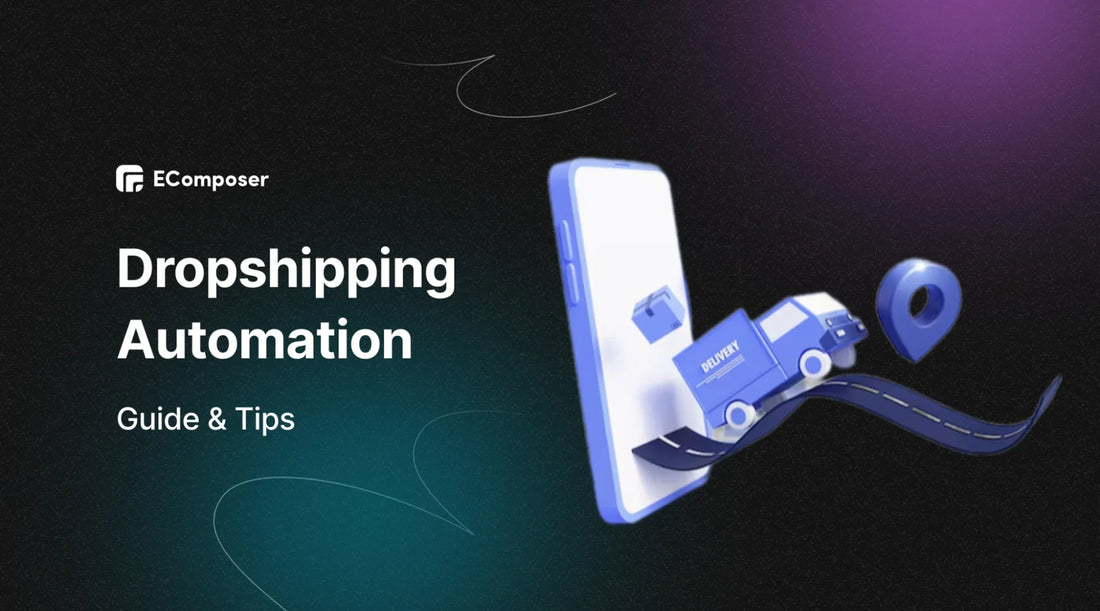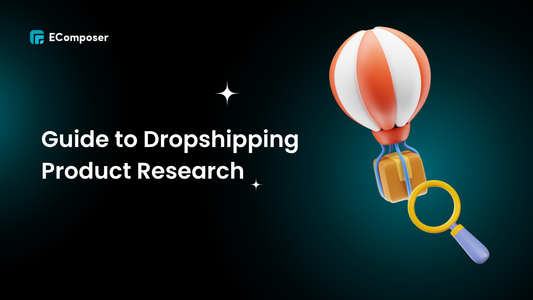How to use dropshipping automation to manage your business

Table Of Contents
What is dropshipping automation?
Dropshipping automation is the use of software tools and systems to streamline and simplify various tasks involved in running a dropshipping business. Instead of manually handling operations like processing orders, updating inventory, adjusting prices, and tracking shipments, automation tools take over these repetitive tasks.
This not only reduces human error but also saves time and improves efficiency, allowing business owners to focus on growth and strategy. From automating order fulfillment to managing customer communication, dropshipping automation helps you run your business more smoothly with minimal manual intervention.
Here’s how it works:
- Product Sourcing: Automation tools connect with supplier catalogs, allowing you to easily add new products to your store and ensuring you have the latest inventory without manual intervention.
- Inventory Management: Automated systems monitor inventory levels in real-time with your suppliers. When items go out of stock or are restocked, your store updates automatically, preventing overselling.
- Order Processing: When a customer places an order, automation tools instantly forward the details to your supplier for fulfillment, eliminating manual order entry and speeding up the process.
- Pricing and Updates: Automation adjusts product prices based on supplier costs or market competition, ensuring your profit margins are maintained without constant oversight.
- Shipping and Tracking: After an order ships, the software automatically updates your store with tracking information, notifying customers without requiring manual input.
- Customer Communication: Automated systems manage customer emails, notifications, and order confirmations, keeping your customers informed and engaged without you having to send individual updates.
By automating these key processes, dropshipping businesses can save time, reduce human errors, and focus on scaling up rather than being bogged down by routine tasks.
The Future of Dropshipping Automation

The future of dropshipping automation is set to revolutionize the eCommerce landscape even further, with advancements in technology continuing to streamline operations and enhance efficiency. Here’s what to expect:
- AI and Machine Learning: Automation tools will become more competent, using AI to predict trends, optimize pricing, and suggest best-selling products based on customer data. Machine learning will help businesses anticipate demand, reduce stock issues, and improve inventory management.
- Personalized Customer Experience: Future automation will allow for more personalized marketing and customer communication. AI-powered chatbots and automated email campaigns will engage customers with tailored messages, boosting conversion rates and enhancing customer satisfaction.
- Advanced Supply Chain Automation: Integration between dropshippers and suppliers will become more seamless, with real-time inventory and shipping updates. Automation could even extend to faster order fulfillment through warehouse robotics, reducing delivery times.
- Voice and Visual Search Integration: As voice and visual search become more popular, automation tools will incorporate these technologies to help customers find products quicker, improving the overall shopping experience.
- Cross-Platform Syncing: Automation will become even more integrated across multiple sales channels, ensuring smooth operation across marketplaces, social media shops, and eCommerce platforms, making multi-channel selling effortless.
- Sustainability Features: Automation may help businesses make eco-friendly decisions by analyzing supply chains and recommending sustainable suppliers or practices, aligning with the growing demand for environmentally conscious business practices.
The future of dropshipping automation promises to be smarter, more efficient, and customer-centric, enabling entrepreneurs to scale their businesses with minimal effort while staying ahead of industry trends.
Why should you utilize dropshipping automation?
Utilizing dropshipping automation offers several compelling advantages that can significantly enhance the efficiency and effectiveness of your business. Here are key reasons to consider:
- Time Savings: Automation handles routine tasks like order processing and inventory tracking, allowing you to focus on strategic growth areas, such as marketing.
- Reduced Errors: Automated systems minimize human errors that can lead to incorrect orders or inventory mistakes, ensuring smoother operations and customer satisfaction.
- Scalability: Automation enables you to manage higher order volumes efficiently as your business grows, reducing the need for additional resources.
- Enhanced Customer Experience: With faster processing and automated updates, customers stay informed and satisfied, boosting repeat business.
- Better Inventory Management: Automated tracking keeps stock levels accurate, preventing overselling and stockouts, which builds trust with your customers.
- Cost Efficiency: While there’s an initial investment in automation tools, long-term savings come from reduced labor and fewer errors, improving profit margins.
- Data Insights: Automation tools offer analytics that reveal trends in sales, customer behavior, and inventory, aiding in smarter, data-driven decisions.
- Competitive Edge: Automation sets you apart by enabling quicker responses and improved service quality, helping attract and retain customers over competitors using manual processes.
Incorporating dropshipping automation into your business model is a strategic move that enhances efficiency, boosts customer satisfaction, and positions your business for growth in a competitive landscape.
Tools and Software for Dropshipping Automation
Order Management Tools
1. Oberlo

Oberlo is a leading dropshipping automation tool specifically designed for Shopify users. It allows entrepreneurs to quickly find products to sell, import them into their Shopify store, and fulfill orders automatically. Oberlo simplifies the process of managing product listings and tracking inventory, making it an ideal solution for new and experienced dropshippers alike.
Features:
- Product import from AliExpress
- Real-time inventory updates
- Order fulfillment automation
- Price and product variant editing
- Analytics and sales tracking
Pros:
- Easy integration with Shopify
- User-friendly interface
- Access to a vast product catalog
- Automates repetitive tasks
- Cost-effective for beginners
Cons:
- Reliance on AliExpress suppliers
- Potentially longer shipping times
2. DSers

DSers is a powerful order management tool that serves as an official AliExpress dropshipping partner. It enables users to quickly place multiple orders, manage inventory, and automate order processing with ease. DSers is designed for efficiency, allowing users to optimize their dropshipping operations and scale their businesses.
Features:
- Bulk order placement
- Supplier management
- Inventory and pricing updates
- Automatic tracking number updates
- Multi-store management
Pros:
- Seamless integration with AliExpress
- Supports multiple eCommerce platforms
- Flexible pricing plans
- Excellent customer support
- User-friendly dashboard
Cons:
- Limited advanced analytics
- Dependent on AliExpress shipping times
Inventory Management Tools
3. Stock Sync

Stock Sync is an inventory management tool that helps dropshippers keep their stock levels accurate across multiple platforms. It automatically syncs inventory from various suppliers, reducing the risk of overselling and stockouts. This tool is essential for those looking to streamline their inventory management processes.
Features:
- Real-time inventory updates
- Multi-source syncing
- CSV upload capability
- Low stock alerts
- Supports various eCommerce platforms
Pros:
- Easy to set up and use
- Saves time on manual updates
- Reduces overselling risk
- Customizable sync frequency
- Excellent for multi-channel selling
Cons:
- Limited reporting features
4. Inventory Source

Inventory Source offers automated inventory management solutions tailored for dropshippers. This tool connects with various suppliers, allowing users to sync products and inventory levels seamlessly. It provides comprehensive features for managing product listings across multiple platforms, making it ideal for growing businesses.
Features:
- Automated product uploads
- Inventory sync across platforms
- Supplier database access
- Order routing automation
- Real-time data updates
Pros:
- Wide range of supplier integrations
- Reduces manual listing efforts
- Offers real-time inventory tracking
- User-friendly interface
- Helps manage multiple stores efficiently
Cons:
- Limited free trial
Customer Support Tools
5. Zendesk

Zendesk is a versatile customer support tool that helps dropshippers manage customer inquiries and support tickets efficiently. With features like live chat, email support, and a ticketing system, Zendesk enables businesses to provide prompt and effective customer service, enhancing customer satisfaction and loyalty.
Features:
- Multi-channel support (chat, email, social media)
- Ticket management system
- Customer self-service options
- Analytics and Reporting
- Customizable support portal
Pros:
- Scalable for growing businesses
- User-friendly interface
- Extensive third-party integrations
- Robust reporting and analytics
- Strong community support
Cons:
- Some users may find it complex initially
- Learning curve for new users
6. Gorgias

Gorgias is a customer support solution tailored for eCommerce businesses. It allows dropshippers to manage customer inquiries from multiple channels in one place. With automation features, such as templated responses and workflow rules, Gorgias helps streamline customer service and improve response times.
Features:
- Integrated helpdesk for email, chat, and social media
- Automated response templates
- Customer order history visibility
- Tagging and filtering tickets
- Analytics and reporting tools
Pros:
- Easy integration with Shopify
- Saves time on customer interactions
- Customizable workflows
- Excellent reporting features
- Strong focus on eCommerce needs
Cons:
- Can be pricey for small businesses
- Some features require time to set up
- Limited integrations outside of eCommerce
Marketing Automation Tools
7. Klaviyo

Klaviyo is an advanced email marketing and automation platform designed for eCommerce businesses. It enables dropshippers to create targeted email campaigns, automate customer segmentation, and track engagement metrics. With its robust analytics, Klaviyo helps businesses optimize their marketing efforts for better ROI.
Features:
- Email campaign automation
- Advanced segmentation and targeting
- Integration with eCommerce platforms
- Real-time analytics and reporting
- A/B testing capabilities
Pros:
- Highly customizable email templates
- Strong data-driven insights
- Excellent integration options
- Scalable for different business sizes
- Focused on eCommerce performance
Cons:
- Can be complex for beginners
- Learning curve for advanced features
8. Omnisend

Omnisend is a marketing automation tool that combines email, SMS, and web push notifications for a comprehensive marketing approach. This platform is designed for eCommerce, enabling dropshippers to engage customers through various channels and automate their marketing workflows effectively.
Features:
- Multi-channel marketing automation
- Pre-built workflows for different customer journeys
- List segmentation and targeting
- Analytics dashboard
- Integration with major eCommerce platforms
Pros:
- User-friendly interface
- Cost-effective for small businesses
- Extensive automation capabilities
- Strong customer support
- Rich media support in emails
Cons:
- Some advanced options may require time to master
- Occasional integration issues with third-party apps
These tools and software solutions for dropshipping automation can significantly enhance the efficiency and effectiveness of your operations, enabling you to focus on growth while minimizing manual work.
Shipping Automation Tools
9. ShipStation

ShipStation is a powerful shipping automation tool designed to simplify the shipping process for eCommerce businesses. It integrates with various eCommerce platforms and carriers, allowing dropshippers to manage orders, print shipping labels, and track shipments all in one place. This streamlines the shipping process and reduces shipping errors.
Features:
- Multi-carrier shipping management
- Shipping label printing
- Order tracking and notifications
- Integration with major eCommerce platforms
- Automation rules for shipping processes
Pros:
- Supports numerous carriers and platforms
- User-friendly interface
- Time-saving automation features
- Detailed analytics and reporting
- Excellent customer support
Cons:
- Some users report a learning curve
10. Easyship

Easyship offers a comprehensive shipping solution for dropshippers, providing access to various shipping options and real-time rates from multiple carriers. The platform helps businesses streamline their shipping processes and offers features like customs documentation and automated notifications.
Features:
- Multi-carrier shipping options
- Real-time shipping rates
- Automated customs documentation
- Branded tracking pages
- Comprehensive analytics dashboard
Pros:
- Wide range of international shipping options
- User-friendly setup
- Excellent for global dropshipping
- Saves time with automated processes
- Strong customer support
Cons:
- Limited integrations with some eCommerce platforms
Website Optimization Tools
11. Shopify

Shopify is one of the most popular eCommerce platforms, offering a comprehensive solution for setting up and managing online stores. For dropshippers, Shopify provides numerous automation apps and integrations that simplify product sourcing, inventory management, and order fulfillment.
Features:
- User-friendly website builder
- App store for additional functionality
- Secure payment processing
- Mobile optimization features
- Built-in SEO tools
Pros:
- Easy to use for beginners
- Extensive app ecosystem for automation
- Reliable hosting and security
- Strong community support and resources
- Great for scaling businesses
Cons:
- Transaction fees for third-party gateways
12. WooCommerce

WooCommerce is a WordPress plugin that allows users to turn their website into a fully functional eCommerce store. It provides dropshippers with a flexible platform for managing products, payments, and shipping, and it supports numerous automation plugins to enhance functionality.
Features:
- Extensive customization options
- Wide range of plugins for additional features
- Secure payment processing
- SEO-friendly structure
- Community support
Pros:
- Open-source and highly customizable
- No transaction fees for built-in payment methods
- Large selection of plugins for dropshipping
- Ideal for users already familiar with WordPress
- Cost-effective for small businesses
Cons:
- Requires more technical knowledge than Shopify
- Need for regular maintenance and updates
Accounting and Financial Management Tools
13. QuickBooks Online

QuickBooks Online is a leading accounting software that helps dropshippers manage their finances, track expenses, and generate invoices. Its automation features simplify bookkeeping tasks, allowing business owners to focus more on their operations rather than financial management.
Features:
- Automated income and expense tracking
- Invoicing and billing features
- Financial reporting and analytics
- Integration with eCommerce platforms
- Tax preparation tools
Pros:
- Extensive reporting capabilities
- Scalable for businesses of all sizes
- Strong customer support
- Mobile app for on-the-go management
Cons:
- Monthly subscription fees can be high
- Learning curve for new users
14. Xero

Xero is another powerful accounting tool that caters to small businesses, including dropshippers. It offers comprehensive financial management features, including invoicing, expense tracking, and real-time collaboration with accountants. Xero's automation capabilities help streamline financial processes.
Features:
- Real-time financial reporting
- Automated invoicing and reminders
- Integration with multiple eCommerce platforms
- Expense tracking via mobile app
- Collaboration features for accountants
Pros:
- User-friendly interface
- Strong integration capabilities
- Excellent mobile app for tracking finances
- Robust reporting features
- Scalable for growing businesses
Cons:
- Monthly fees can be costly for small businesses
- Some users may find the feature set overwhelming
- Limited customer support availability
Product Research Tools
15. AliShark

AliShark is a product research tool that helps dropshippers identify trending products on AliExpress. It provides real-time data on sales volume, pricing trends, and competition analysis, allowing entrepreneurs to make informed decisions about what to sell.
Features:
- Real-time product tracking
- Sales and pricing analytics
- Competitor analysis
- Trending product notifications
- User-friendly interface
Pros:
- Helps discover profitable products quickly
- Comprehensive data for informed decisions
- Easy to use for beginners
- Regularly updated database
- Excellent for market research
Cons:
- Limited to AliExpress products
- Less useful for non-dropshipping models
16. Thieve.co

Thieve.co is another tool for dropshippers that curates trending products from AliExpress, focusing on high-quality items. It helps entrepreneurs discover unique products and provides insights into market trends, making it easier to find items that resonate with their target audience.
Features:
- Curated product lists from AliExpress
- Trend analysis and market insights
- User-friendly interface
- Direct links to product pages
- Regularly updated selections
Pros:
- Simplifies the product discovery process
- Focus on quality and trending items
- Excellent for niche markets
- Saves time on product research
- Easy to integrate with dropshipping stores
Cons:
- Product availability may vary
- Less comprehensive data compared to other tools
Read more: Best Dropshipping Products 2024
Analytics and Reporting Tools
17. Google Analytics

Google Analytics is a powerful tool for tracking website traffic and user behavior, which is essential for dropshippers looking to optimize their stores. It provides valuable insights into customer demographics, engagement, and conversion rates, allowing business owners to make data-driven decisions.
Features:
- Comprehensive traffic analysis
- User behavior tracking
- Conversion tracking
- Customizable dashboards
- Real-time reporting
Pros:
- Free to use with extensive features
- Helps identify trends and customer preferences
- Integrates seamlessly with eCommerce platforms
- Excellent for SEO optimization
- Robust reporting capabilities
Cons:
- Can be overwhelming for beginners
- Requires time to learn effectively
- Data may take time to process
18. Hotjar

Hotjar is a user behavior analytics tool that provides insights into how visitors interact with your website. With features like heatmaps, session recordings, and feedback polls, dropshippers can identify areas for improvement and optimize the customer experience.
Features:
- Heatmaps to visualize user interaction
- Session recordings to analyze the behavior
- Feedback polls and surveys
- Conversion funnels
- Integration with various platforms
Pros:
- Visual insights into user behavior
- Easy to use and set up
- Helps improve user experience
- Supports decision-making for design changes
- Cost-effective pricing plans
Cons:
- Limited features in the free plan
- Some users report data lag
- Requires time to analyze and implement changes
Sales Funnel Tools
19. ClickFunnels

ClickFunnels is a comprehensive sales funnel builder that helps dropshippers create optimized sales processes. With its drag-and-drop interface, users can build landing pages, sales pages, and order forms to enhance conversions and streamline customer journeys.
Features:
- Drag-and-drop page builder
- Pre-built funnel templates
- A/B testing capabilities
- Email marketing automation
- Analytics and Reporting
Pros:
- Increases conversion rates through optimized funnels
- All-in-one solution for sales processes
- Strong customer support and community
- Regularly updated with new features
Cons:
- Monthly subscription can be high
- Some features may require technical knowledge
- Learning curve for more advanced options
20. Leadpages

Leadpages is a landing page builder designed to help businesses create high-converting landing pages quickly. For dropshippers, it offers templates optimized for sales funnels, enabling effective lead generation and customer acquisition.
Features:
- Drag-and-drop landing page builder
- A/B testing and analytics
- Integration with various email marketing tools
- Mobile-responsive templates
- Pop-ups and alert bars
Pros:
- Easy to use for beginners
- Increases lead generation and conversions
- Integrates with significant marketing platforms
- Strong customer support
Cons:
- Some users may find templates restrictive
How to Implement Automation in Your Dropshipping Business

Implementing automation in your dropshipping business can save you time, increase efficiency, and help you scale operations. Here’s a detailed step-by-step guide to effectively integrate automation into your dropshipping workflow:
Step 1: Define Your Automation Goals
Identify Areas for Automation:
- Order Management: Automate order processing to reduce manual work.
- Inventory Management: Set up automatic stock updates to prevent overselling.
- Customer Communication: Automate emails for order confirmations, shipping notifications, and follow-ups.
- Data Analysis: Use automation tools to track and analyze sales data for better decision-making.
Step 2: Choose the Right eCommerce Platform
Select a platform that supports automation:
- Shopify: Offers various automation apps and integrations.
- WooCommerce: Supports automation plugins to manage orders and inventory.
- BigCommerce: Includes built-in features for dropshipping automation.
Step 3: Set Up Your Dropshipping Store
- Create Your Online Store:
- Choose a domain name and design your website using themes.
- Add essential pages like About, Contact, and Privacy Policy.
- Integrate Dropshipping Suppliers:
- Use apps like Oberlo (for Shopify) or Spocket to connect with suppliers.
- Ensure your supplier supports automation and provides reliable product feeds.
Step 4: Implement Order Management Automation
Utilize Tools for Streamlined Order Processing:
- Automate Order Fulfillment: Use software like ShipStation or Ordoro to forward orders to suppliers automatically.
- Set Up Triggers: Configure triggers to automatically send order details to suppliers when a purchase is made.
Step 5: Integrate Inventory Management
Use Automation Tools for Stock Management:
- Inventory Syncing: Employ tools like Inventory Source or Skubana to sync inventory levels between your store and suppliers automatically.
- Low Stock Alerts: Set alerts to notify you when inventory is running low, preventing stockouts.
Step 6: Automate Customer Communication
Set Up Email Marketing Automation:
- Choose an Email Marketing Tool:
- Platforms like Mailchimp, Klaviyo, or Sendinblue can help automate customer communication.
- Create Automated Email Sequences:
- Order Confirmation Emails: Automatically send order details and confirmation messages.
- Shipping Notifications: Notify customers about shipping status and tracking information.
- Follow-up Emails: Send automated thank-you emails or request reviews after purchase.
Step 7: Implement Marketing Automation
Automate Your Marketing Efforts:
- Social Media Scheduling: Use tools like Buffer or Hootsuite to schedule posts across platforms automatically.
- Retargeting Ads: Set up automated retargeting campaigns to reach visitors who didn’t complete a purchase.
Step 8: Utilize Data Analytics Tools
Automate Data Tracking and Reporting:
- Set Up Google Analytics: Track website traffic, conversion rates, and customer behavior.
- Automated Reporting Tools: Use software like Databox or Google Data Studio to create real-time dashboards that summarize your business performance.
Step 9: Optimize and Test Your Automation
Continuously Monitor and Improve:
- Analyze Automation Performance: Regularly review the effectiveness of your automated processes and make adjustments as needed.
- A/B Testing: Test different automation strategies, such as email subject lines or ad creatives, to find what works best for your audience.
Step 10: Scale and Expand
Expand Your Automation Efforts:
- Explore Additional Tools: As your business grows, consider integrating advanced tools like CRM systems (e.g., HubSpot or Salesforce) to manage customer relationships.
- Implement Advanced Automation: Look into using artificial intelligence and machine learning tools for customer service (like chatbots) or predictive analytics for inventory management.
May you interest
- How to Make Money with Dropshipping
- Dropshipping Business Ideas
- Tips For Dropshipping To Maximize Profits
- Shopify Dropshipping Stores Designs + Tactics
Challenges of Dropshipping Automation

Implementing dropshipping automation can significantly streamline your business processes, but it also comes with its share of challenges. Here are some common obstacles and practical solutions to overcome them:
1. Integration Issues
Challenge: Not all tools and platforms seamlessly integrate, which can lead to data silos and inefficient workflows.
Solution:
- Research Before You Invest: Choose automation tools that are compatible with your eCommerce platform. Read reviews and seek recommendations from other dropshippers.
- Utilize Middleware: Consider using integration platforms like Zapier or Integromat (Make) to connect disparate systems and automate data flow between them.
2. Supplier Reliability
Challenge: Automating order fulfillment can lead to issues if your suppliers are reliable, resulting in delays and customer satisfaction.
Solution:
- Vet Suppliers Thoroughly: Choose suppliers with proven track records and positive reviews. Consider those who offer reliable shipping times and quality products.
- Implement Backup Suppliers: Have alternative suppliers lined up for your best-selling products in case of supply chain disruptions.
3. Inventory Management Challenges
Challenge: Automating inventory updates can lead to overselling if the integration needs to be correctly configured.
Solution:
- Set Up Real-Time Syncing: Use tools that provide real-time inventory syncing to keep stock levels accurate across all platforms.
- Monitor Inventory Levels: Regularly check inventory levels and set up alerts for low stock to manually intervene if necessary.
4. Customer Service Automation Pitfalls
Challenge: Over-automating customer service can lead to impersonal experiences that frustrate customers who prefer human interaction.
Solution:
- Balance Automation and Human Touch: Use chatbots for initial inquiries but provide easy access to human representatives for complex issues.
- Personalize Automated Messages: Ensure automated communications (like follow-up emails) feel personal and include the customer’s name and relevant details.
5. Technical Issues and Downtime
Challenge: Software glitches or server downtimes can disrupt automated processes, causing order delays and customer complaints.
Solution:
- Choose Reliable Software Providers: Opt for reputable tools with a history of uptime and customer support.
- Have a Contingency Plan: Create a manual process for order fulfillment and customer communication that can be activated during technical issues.
6. Cost of Automation Tools
Challenge: Investing in multiple automation tools can become expensive, particularly for small businesses.
Solution:
- Prioritize Key Automation: Focus on automating the most impactful areas of your business first, such as order management and customer communication, before adding additional tools.
- Look for All-in-One Solutions: Consider platforms that offer multiple features in one package to reduce overall costs.
7. Data Privacy and Compliance
Challenge: Automating processes often involves handling sensitive customer data, which can lead to compliance issues with regulations like GDPR or CCPA.
Solution:
- Implement Data Protection Measures: Use secure platforms and ensure that your automation tools comply with data privacy regulations.
- Educate Your Team: Keep your team informed about data handling practices and compliance requirements.
8. Over-Reliance on Automation
Challenge: Relying too heavily on automation can make your business less adaptable to changes in the market or customer preferences.
Solution:
- Maintain a Flexible Approach: Regularly review and adjust your automated processes based on market trends and customer feedback.
- Encourage Employee Involvement: Involve your team in decision-making processes to leverage their insights and creativity alongside automation.
9. Scaling Automation Effectively
Challenge: As your business grows, scaling automation processes can be complex and resource-intensive.
Solution:
- Start Small: Begin with automating core functions and gradually add complexity as your business scales.
- Monitor Performance Metrics: Regularly assess the performance of automated processes to identify bottlenecks and areas for improvement.
Wrapping Up
In conclusion, embracing dropshipping automation can transform how you manage your business. By streamlining order processing, inventory updates, and customer communication, you’ll save time and reduce errors. Focus on integrating the right tools to enhance efficiency while maintaining a personal touch with your customers. With the right approach, automation not only simplifies your operations but also helps you scale and thrive in the competitive eCommerce landscape. Start automating today!





















0 comments